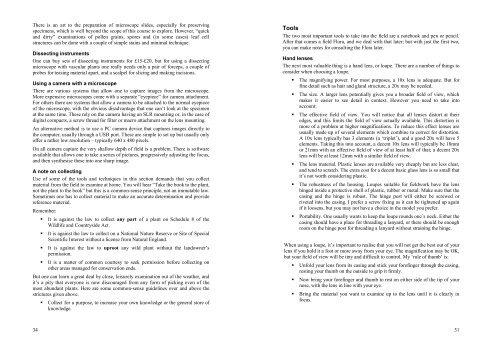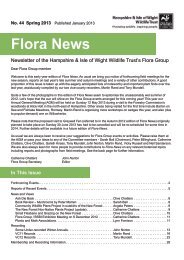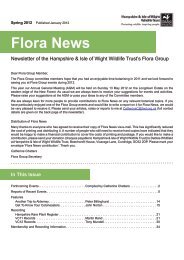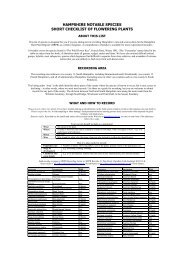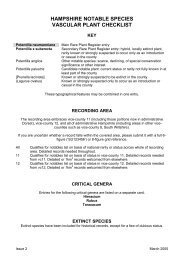An A5 booklet version as distributed in the - Hants Plants
An A5 booklet version as distributed in the - Hants Plants
An A5 booklet version as distributed in the - Hants Plants
You also want an ePaper? Increase the reach of your titles
YUMPU automatically turns print PDFs into web optimized ePapers that Google loves.
There is an art to <strong>the</strong> preparation of microscope slides, especially for preserv<strong>in</strong>g<br />
specimens, which is well beyond <strong>the</strong> scope of this course to explore. However, “quick<br />
and dirty” exam<strong>in</strong>ations of pollen gra<strong>in</strong>s, spores and (<strong>in</strong> some c<strong>as</strong>es) leaf cell<br />
structures can be done with a couple of simple sta<strong>in</strong>s and m<strong>in</strong>imal technique.<br />
Dissect<strong>in</strong>g <strong>in</strong>struments<br />
One can buy sets of dissect<strong>in</strong>g <strong>in</strong>struments for £15-£20, but for us<strong>in</strong>g a dissect<strong>in</strong>g<br />
microscope with v<strong>as</strong>cular plants one really needs only a pair of forceps, a couple of<br />
probes for te<strong>as</strong><strong>in</strong>g material apart, and a scalpel for slic<strong>in</strong>g and mak<strong>in</strong>g <strong>in</strong>cisions.<br />
Us<strong>in</strong>g a camera with a microscope<br />
There are various systems that allow one to capture images from <strong>the</strong> microscope.<br />
More expensive microscopes come with a separate “eyepiece” for camera attachment.<br />
For o<strong>the</strong>rs <strong>the</strong>re are systems that allow a camera to be attached to <strong>the</strong> normal eyepiece<br />
of <strong>the</strong> microscope, with <strong>the</strong> obvious disadvantage that one can’t look at <strong>the</strong> specimen<br />
at <strong>the</strong> same time. These rely on <strong>the</strong> camera hav<strong>in</strong>g an SLR mount<strong>in</strong>g or, <strong>in</strong> <strong>the</strong> c<strong>as</strong>e of<br />
digital compacts, a screw thread for filter or macro attachment on <strong>the</strong> lens mount<strong>in</strong>g.<br />
<strong>An</strong> alternative method is to use a PC camera device that captures images directly to<br />
<strong>the</strong> computer, usually through a USB port. These are simple to set up but usually only<br />
offer a ra<strong>the</strong>r low resolution – typically 640 x 480 pixels.<br />
On all camera capture <strong>the</strong> very shallow depth of field is a problem. There is software<br />
available that allows one to take a series of pictures, progressively adjust<strong>in</strong>g <strong>the</strong> focus,<br />
and <strong>the</strong>n syn<strong>the</strong>sise <strong>the</strong>se <strong>in</strong>to one sharp image.<br />
A note on collect<strong>in</strong>g<br />
Use of some of <strong>the</strong> tools and techniques <strong>in</strong> this section demands that you collect<br />
material from <strong>the</strong> field to exam<strong>in</strong>e at home. You will hear “Take <strong>the</strong> book to <strong>the</strong> plant,<br />
not <strong>the</strong> plant to <strong>the</strong> book” but this is a common-sense pr<strong>in</strong>ciple, not an immutable law.<br />
Sometimes one h<strong>as</strong> to collect material to make an accurate determ<strong>in</strong>ation and provide<br />
reference material.<br />
Remember:<br />
34<br />
It is aga<strong>in</strong>st <strong>the</strong> law to collect any part of a plant on Schedule 8 of <strong>the</strong><br />
Wildlife and Countryside Act.<br />
It is aga<strong>in</strong>st <strong>the</strong> law to collect on a National Nature Reserve or Site of Special<br />
Scientific Interest without a license from Natural England.<br />
It is aga<strong>in</strong>st <strong>the</strong> law to uproot any wild plant without <strong>the</strong> landowner’s<br />
permission.<br />
It is a matter of common courtesy to seek permission before collect<strong>in</strong>g on<br />
o<strong>the</strong>r are<strong>as</strong> managed for conservation ends.<br />
But one can learn a great deal by close, leisurely exam<strong>in</strong>ation out of <strong>the</strong> wea<strong>the</strong>r, and<br />
it’s a pity that everyone is now discouraged from any form of pick<strong>in</strong>g even of <strong>the</strong><br />
most abundant plants. Here are some common-sense guidel<strong>in</strong>es over and above <strong>the</strong><br />
strictures given above.<br />
Collect for a purpose, to <strong>in</strong>cre<strong>as</strong>e your own knowledge or <strong>the</strong> general store of<br />
knowledge.<br />
Tools<br />
The two most important tools to take <strong>in</strong>to <strong>the</strong> field are a notebook and pen or pencil.<br />
After that comes a field Flora, and we deal with that later; but with just <strong>the</strong> first two,<br />
you can make notes for consult<strong>in</strong>g <strong>the</strong> Flora later.<br />
Hand lenses<br />
The next most valuable th<strong>in</strong>g is a hand lens, or loupe. There are a number of th<strong>in</strong>gs to<br />
consider when choos<strong>in</strong>g a loupe.<br />
The magnify<strong>in</strong>g power. For most purposes, a 10x lens is adequate. But for<br />
f<strong>in</strong>e detail such <strong>as</strong> hair and gland structure, a 20x may be needed.<br />
The size. A larger lens potentially gives you a broader field of view, which<br />
makes it e<strong>as</strong>ier to see detail <strong>in</strong> context. However you need to take <strong>in</strong>to<br />
account:<br />
The effective field of view. You will notice that all lenses distort at <strong>the</strong>ir<br />
edges, and this limits <strong>the</strong> field of view actually available. This distortion is<br />
more of a problem at higher magnifications. To reduce this effect lenses are<br />
usually made up of several elements which comb<strong>in</strong>e to correct for distortion.<br />
A 10x lens typically h<strong>as</strong> 3 elements (a ‘triplet’), and a good 20x will have 5<br />
elements. Tak<strong>in</strong>g this <strong>in</strong>to account, a decent 10x lens will typically be 18mm<br />
or 21mm with an effective field of view of at le<strong>as</strong>t half of that; a decent 20x<br />
lens will be at le<strong>as</strong>t 12mm with a similar field of view.<br />
The lens material. Pl<strong>as</strong>tic lenses are available very cheaply but are less clear,<br />
and tend to scratch. The extra cost for a decent b<strong>as</strong>ic gl<strong>as</strong>s lens is so small that<br />
it’s not worth consider<strong>in</strong>g pl<strong>as</strong>tic.<br />
The robustness of <strong>the</strong> hous<strong>in</strong>g. Loupes suitable for fieldwork have <strong>the</strong> lens<br />
h<strong>in</strong>ged <strong>in</strong>side a protective shell of pl<strong>as</strong>tic, rubber or metal. Make sure that <strong>the</strong><br />
c<strong>as</strong><strong>in</strong>g and <strong>the</strong> h<strong>in</strong>ge is robust. The h<strong>in</strong>ge post will ei<strong>the</strong>r be screwed or<br />
riveted <strong>in</strong>to <strong>the</strong> c<strong>as</strong><strong>in</strong>g. I prefer a screw fix<strong>in</strong>g <strong>as</strong> it can be tightened up aga<strong>in</strong><br />
if it loosens, but you may not have a choice <strong>in</strong> <strong>the</strong> model you prefer.<br />
Portability. One usually wants to keep <strong>the</strong> loupe rounds one’s neck. Ei<strong>the</strong>r <strong>the</strong><br />
c<strong>as</strong><strong>in</strong>g should have a place for thread<strong>in</strong>g a lanyard, or <strong>the</strong>re should be enough<br />
room on <strong>the</strong> h<strong>in</strong>ge post for thread<strong>in</strong>g a lanyard without stra<strong>in</strong><strong>in</strong>g <strong>the</strong> h<strong>in</strong>ge.<br />
When us<strong>in</strong>g a loupe, it’s important to realise that you will not get <strong>the</strong> best out of your<br />
lens if you hold it a foot or more away from your eye. The magnification may be OK,<br />
but your field of view will be t<strong>in</strong>y and difficult to control. My ‘rule of thumb’ is:<br />
Unfold your lens from its c<strong>as</strong><strong>in</strong>g and stick your foref<strong>in</strong>ger through <strong>the</strong> c<strong>as</strong><strong>in</strong>g,<br />
rest<strong>in</strong>g your thumb on <strong>the</strong> outside to grip it firmly.<br />
Now br<strong>in</strong>g your foref<strong>in</strong>ger and thumb to rest on ei<strong>the</strong>r side of <strong>the</strong> tip of your<br />
nose, with <strong>the</strong> lens <strong>in</strong> l<strong>in</strong>e with your eye.<br />
Br<strong>in</strong>g <strong>the</strong> material you want to exam<strong>in</strong>e up to <strong>the</strong> lens until it is clearly <strong>in</strong><br />
focus.<br />
31


